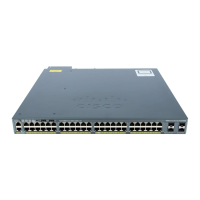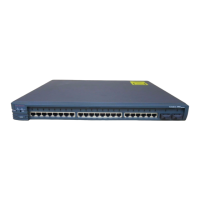After the switch detects a powered device, the switch determines the device power requirements and then
grants or denies power to the device. The switch can also sense the real-time power consumption of the device
by monitoring and policing the power usage.
Supported Protocols and Standards
The switch uses these protocols and standards to support PoE:
• CDP with power consumption—The powered device notifies the switch of the amount of power it is
consuming. The switch does not reply to the power-consumption messages. The switch can only supply
power to or remove power from the PoE port.
• Cisco intelligent power management—The powered device and the switch negotiate through
power-negotiation CDP messages for an agreed-upon power-consumption level. The negotiation allows
a high-power Cisco powered device, which consumes more than 7 W, to operate at its highest power
mode. The powered device first boots up in low-power mode, consumes less than 7 W, and negotiates
to obtain enough power to operate in high-power mode. The device changes to high-power mode only
when it receives confirmation from the switch.
High-power devices can operate in low-power mode on switches that do not support power-negotiation
CDP.
Cisco intelligent power management is backward-compatible with CDP with power consumption; the
switch responds according to the CDP message that it receives. CDP is not supported on third-party
powered devices; therefore, the switch uses the IEEE classification to determine the power usage of the
device.
• IEEE 802.3af—The major features of this standard are powered-device discovery, power administration,
disconnect detection, and optional powered-device power classification. For more information, see the
standard.
• IEEE 802.3at—The PoE+ standard increases the maximum power that can be drawn by a powered
device from 15.4 W per port to 30 W per port.
Powered-Device Detection and Initial Power Allocation
The switch detects a Cisco pre-standard or an IEEE-compliant powered device when the PoE-capable port is
in the no-shutdown state, PoE is enabled (the default), and the connected device is not being powered by an
AC adaptor.
After device detection, the switch determines the device power requirements based on its type:
•
A Cisco prestandard powered device does not provide its power requirement when the switch detects
it, so a switch that does not support PoE+ allocates 15.4 W as the initial allocation for power budgeting;
a PoE+ switch allocates 30 W (PoE+).
The initial power allocation is the maximum amount of power that a powered device requires. The switch
initially allocates this amount of power when it detects and powers the powered device. As the switch
receives CDP messages from the powered device and as the powered device negotiates power levels
with the switch through CDP power-negotiation messages, the initial power allocation might be adjusted.
•
The switch classifies the detected IEEE device within a power consumption class. Based on the available
power in the power budget, the switch determines if a port can be powered. Table 12: IEEE Power
Classifications, on page 85 lists these levels.
Catalyst 2960-XR Switch Interface and Hardware Component Configuration Guide, Cisco IOS Release 15.0(2)EX1
84 OL-29420-01
Configuring PoE
Power over Ethernet Ports

